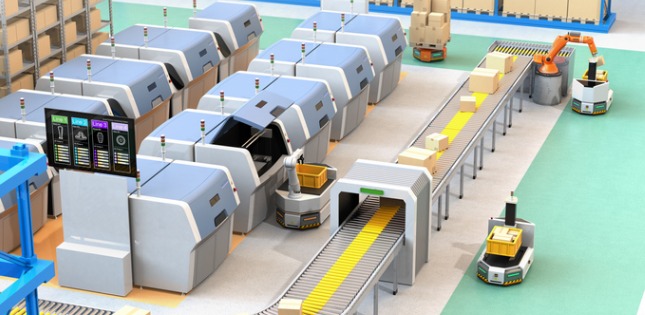3 min read
634 AI: Putting Vision into Motion with Autonomous Mobile Robots
 Onn Fenig
:
January 11, 2022
Onn Fenig
:
January 11, 2022

The logistics automation landscape is changing rapidly. There are so many incredible projects out there, implementing Autonomous Mobile Robots (AMRs) with growing capabilities. However, with typical AMRs, all the computation, navigation, processing power and network capabilities are onboard the robot itself – and the fact is, they just aren’t affordable.
Say you’re managing an industrial work floor – you have processes in place already. You know AMRs could streamline your logistics movements, but you have to spend an awful lot to get the functionality you need. And then you have to retrofit into your work floor and manage maintenance costs for what may end up being an expensive experiment. There needs to be an expansion of the implementation model. Cost-effective solutions can enable businesses to take that leap integrating autonomous robots. The Robot-as-a-Service approach gives that flexibility to businesses, and more than that, it helps build trust in autonomous technologies.
An enormous challenge for AMRs is that of interoperability. Each AMR vendor implements its own control software, navigation software, fleet management software and even data format and repository.
On top of price, you have the challenge of trying to achieve interoperability between discrete systems that were designed in silo and weren’t designed to communicate with each other in the first place. When developing MAESTRO, we wanted to tackle these challenges, to make the move to autonomous mobility more accessible, trustworthy and cost-effective. When envisioning the industrial floor of the future, we saw a plethora of different AMRs of different vendors and functionalities working in tandem on busy floors populated with people and other mobile devices, all needing to co-exist and interoperate with each other.
So we took a step back to look at the bigger challenges on the industrial work floor, to create a floor management system that can enable integrated functionality across the work floor in a holistic manner, looking at the full process and not only at the device level. That’s where RTI came into the picture.
634 AI and RTI Connext: The Advantages of a Common Shared Infrastructure
We chose the RTI Connext® software because it supports fast, reliable communication between the MAESTRO system and AMRs with near-zero latency for critical data, while also providing fool-proof real-time connectivity. Choosing Connext allowed the combined team to ease deployment and avoid unnecessary time in building out the scalable messaging system we needed. This enhanced the capabilities of MAESTRO, allowing customers to have comprehensive real-time floor mapping. It also helped provide a safer workplace for employees by reducing collision costs and lowering overall risk on the work floor.
With RTI’s proven software connectivity platform, 634 AI now has a common shared infrastructure to develop, deploy and maintain fully interoperable systems which are not only interoperable at the AMR level, but also interoperable with other IoT devices on the floor or in the facility. The combination of MAESTRO and Connext allows us to create a unique, cost-saving business model for our customers, with a simple monthly IMaaS (Indoor Mobility as a Service) licensing fee for all their indoor mobility requirements
RTI worked closely with us to achieve our goals. It was clear from the start that the relationship wasn’t like that of a vendor, but rather a partner. We were driven by a shared mission: to enable widespread, future-proof adoption of AMRs.
Our IMaaS model is gaining popularity as a solution, thanks to the ability of next-generation technology to harness intelligence and deliver levels of efficiency that were previously undreamt-of. This model opens the possibility of automation for industries that were previously priced out of the market, due to the cost of acquiring and owning highly sophisticated AMRs or RTLS devices. Not only does this allow customers to transform their work floors, but it also allows manufacturers to focus on new innovations while the challenges of autonomous mobility are taken care of!
If pursuing an Indoor Mobility as-a-Service model is part of your strategy, we here at 634 AI would love to work with you. To find out more about how 634 AI can help, visit us on the web here.
About the author

Onn Fenig is the CEO of 634 AI, the developer of MAESTRO, an AI powered Control Tower for orchestrating indoor mobility. With more than 20 years’ experience, Onn has assumed CEO and other senior management positions in companies such as Rioglass Solar, Siemens and Cisco Systems, and is passionate about how disruptive technologies can be used to create a real impact on humanity.
Posts by Tag
- Developers/Engineer (177)
- Connext DDS Suite (77)
- Technology (74)
- News & Events (73)
- 2020 (54)
- Standards & Consortia (51)
- Aerospace & Defense (48)
- Automotive (35)
- 2023 (34)
- 2022 (29)
- IIoT (27)
- Leadership (24)
- 2024 (22)
- Cybersecurity (20)
- Healthcare (20)
- 2021 (19)
- Connectivity Technology (16)
- Military Avionics (15)
- Culture & Careers (14)
- FACE (13)
- Connext DDS Pro (10)
- JADC2 (10)
- ROS 2 (10)
- 2025 (8)
- Connext DDS Tools (7)
- Connext DDS Micro (6)
- Databus (6)
- Transportation (5)
- Case + Code (4)
- Connext DDS (4)
- Connext DDS Cert (4)
- Energy Systems (4)
- FACE Technical Standard (4)
- Oil & Gas (3)
- RTI Labs (3)
- Research (3)
- Robotics (3)
- #A&D (2)
- Connext Conference (2)
- Edge Computing (2)
- MDO (2)
- MS&T (2)
- TSN (2)
- ABMS (1)
- C4ISR (1)
- ISO 26262 (1)
- L3Harris (1)
- LabView (1)
- MathWorks (1)
- National Instruments (1)
- Simulation (1)
- Tech Talks (1)
- UAM (1)
- Videos (1)
- eVTOL (1)
 Success-Plan Services
Success-Plan Services